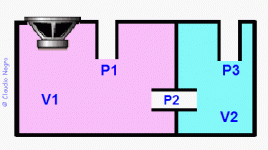I've got some Rega Ayla speakers that I can't find much info on online. What I have found is that the drivers are in a sealed chamber with a second chamber which is ported. I don't know if this is correct but if it is what is this design called and what goals are they trying to achieve with this design?
Thanks
Thanks
There is a design where an acoustic filter, consisting of a solid shelf cut with narrow slits, is placed halfway down the enclosure. Only bass frequencies can travel into the lower half of the enclosure which therefore requires no absorbent lining. The reflex port in the lower half of the enclosure will emit only bass frequencies and no spurious higher frequencies.
That is "theory" (i.e. marketing) and in the real life it is a variant of double-chamber bass-reflex box (DBR), with already known dubious "improvements" over conventional bass-reflex design. Have seen exactly the same design some 30 years ago in a short-lived (now defunct) american loudspeaker company (forgot the name).
The acoustic filter/bass reflex design was introduced by Gilbert Briggs of Wharfedale fame over 60 years ago.
Its original purpose was to reduce LF cone excursions induced by turntable motor rumble.
The filter also removes one of the two impedance humps seen in ordinary reflex loading so that tuning is less critical, and the dip in response due to the vertical standing wave is avoided.
Its original purpose was to reduce LF cone excursions induced by turntable motor rumble.
The filter also removes one of the two impedance humps seen in ordinary reflex loading so that tuning is less critical, and the dip in response due to the vertical standing wave is avoided.
I presume you have removed the bass driver and looked inside, rjbell.

If possible, examine the partition between the upper and lower chambers closely.
The UK Hi-Fi History Society link below shows the vintage plans for an acoustic filter/bass reflex enclosure - refer to Cabinet 2.
http://ukhhsoc.torrens.org/makers/Stentorian/Gatefold_Leaflet_GA4188_4M_367/Back.jpeg
I include it so that you may determine whether or not this is the design Rega have employed.
If possible, examine the partition between the upper and lower chambers closely.
The UK Hi-Fi History Society link below shows the vintage plans for an acoustic filter/bass reflex enclosure - refer to Cabinet 2.
http://ukhhsoc.torrens.org/makers/Stentorian/Gatefold_Leaflet_GA4188_4M_367/Back.jpeg
I include it so that you may determine whether or not this is the design Rega have employed.
As can be seen from the image, there is only one bass reflex port, which is located at the bottom rear of the Rega Alya.

Last edited:
No, I was reffering to this:Sonce refers to a "double-chamber bass-reflex box (DBR)", the design of which is illustrated in the attachment.
This is DBR, not DCR.
Thanks, Sonce.
If rjbell examines the partition between the two chambers, he will be able to tell whether there is an internal port or an acoustic filter.
P.S. The Wharfedale acoustic filter consisted of a number of 1/16" slits which required no felt covering to increase the acoustic resistance as was done in the Whiteley Cabinet 2.
If rjbell examines the partition between the two chambers, he will be able to tell whether there is an internal port or an acoustic filter.
P.S. The Wharfedale acoustic filter consisted of a number of 1/16" slits which required no felt covering to increase the acoustic resistance as was done in the Whiteley Cabinet 2.
...what is this design called and what goals are they trying to achieve with this design?
Here are the claimed advantages of the double bass reflex (DBR) illustrated by Sonce:
The double bass-reflex (DBR) speaker system is a variation of the standard bass-reflex (BR) enclosure that is intended to achieve further extension of the bass response. The augmentation to the bass output is achieved by the use an additional chamber in the bass-reflex process. Other advantages of the double bass-reflex speaker compared to a conventional bass-reflex system are a reduction of the cone excursion around F3 and a corresponding reduction [in] distortion. The use of an additional chamber in the speaker enclosure also reduces the likelihood of resonances.
https://diyaudioprojects.com/Speakers/Fostex-FE206En-Double-Bass-Reflex-Speakers/#:~:text=The double bass-reflex (DBR) speaker system is a,use an additional chamber in the bass-reflex process.
As Sonce implies, I believe it is pretty difficult to get the complex DBR design just riight.
What I have found is that the drivers are in a sealed chamber with a second chamber which is ported.
That statement implies there is no internal port and lends credence to the acoustic filter/bass reflex description.
Do let us know what your further explorations reveal, rjbell.
This is what i read somewhere. I will look inside to find out. Thanks for all the help.That statement implies there is no internal port and lends credence to the acoustic filter/bass reflex description.
Do let us know what your further explorations reveal, rjbell.
In a tower like that adding a vented aperiodic second chamber also does a lot to kill the quarter-wave loading it would have with no partition.
dave
An hex key size so not huge. Can't believe how clumsy. I'll keep an eye out for a spare online.Oh dear! 😱
How bad is it?
- Home
- Loudspeakers
- Multi-Way
- Two chamber speaker cabinet with the drivers in a sealed chamber.
